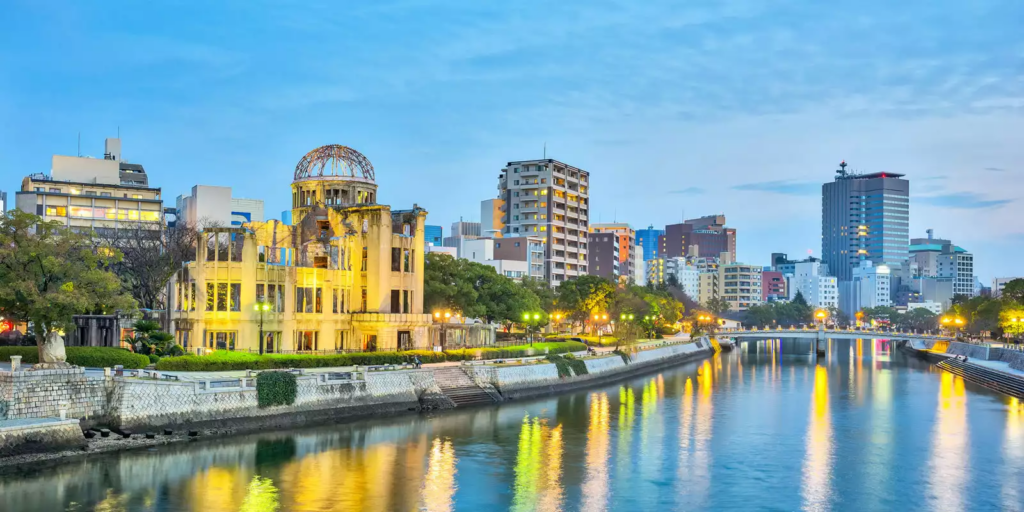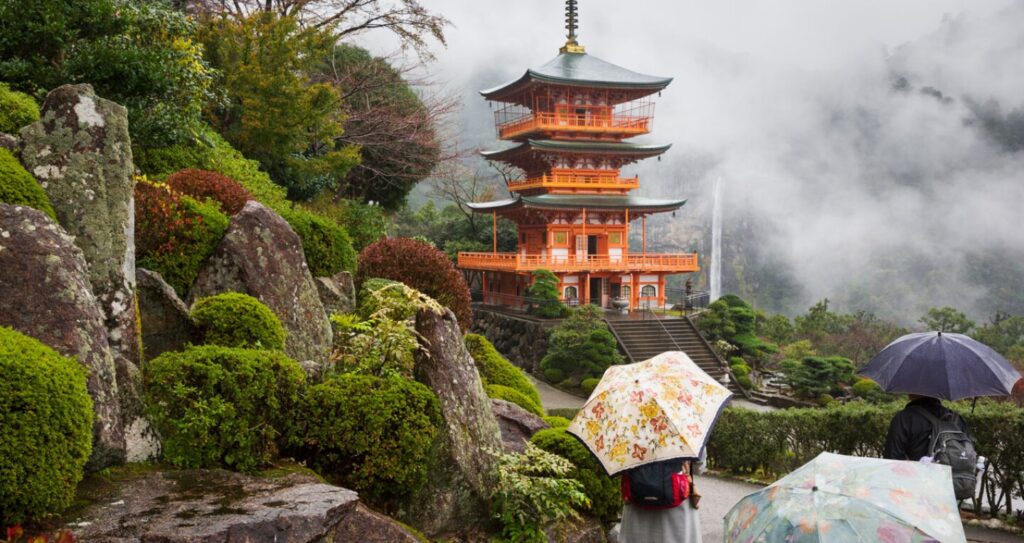Japan is a country renowned for its rich cultural heritage, stunning natural landscapes, and vibrant modern cities. From ancient temples nestled among serene cherry blossom trees to bustling streets pulsating with neon lights, Japan offers a diverse array of experiences for travelers. Whether you’re drawn to the tranquility of traditional tea ceremonies or the excitement of cutting-edge technology, there’s something to captivate every visitor.
In this article, we’ll explore the top ten must-visit destinations in Japan, each offering its own unique blend of history, culture, and innovation. Join us on a journey through this enchanting land as we uncover the gems that make Japan a truly unforgettable destination.
1. Tokyo

Tokyo, a city constantly evolving towards the horizon, continuously challenges the limits of what can be achieved on its densely packed, earthquake-prone terrain. With each passing day, it erects taller, sleeker structures, epitomizing Japan’s relentless pursuit of innovation. Known as the pinnacle of contemporary art, architecture, and pop culture, Tokyo stands as the ultimate destination for shopping, dining, and entertainment—rivaled only by Kyoto in its culinary offerings. Yet, beyond its vibrant attractions lies the true allure of Tokyo itself. It’s an expansive, dynamic entity, sprawling endlessly before the beholder’s gaze. Defined by its diverse array of neighborhoods, Tokyo promises a unique adventure with every visit, ensuring that no two experiences within its bustling streets are ever alike.
2. Kyoto

Kyoto, once the majestic capital of Japan for a millennium, boasts an impressive collection of over a thousand temples, each with its own unique charm. From the awe-inspiring grandeur of Kinkaku-ji, a breathtaking pavilion adorned entirely in shimmering gold leaf, to the serene simplicity of Ryōan-ji’s Zen rock garden, there’s a spiritual haven for every visitor. But Kyoto’s allure doesn’t end with its temples. Dive into the elegant world of tea culture at one of its refined teahouses, immerse yourself in the artistry of geisha performances, and tantalize your taste buds with the delights of kaiseki, Japan’s haute cuisine. In Kyoto, every corner reveals a new facet of its rich tapestry of tradition, inviting you to explore and savor its cultural treasures.
3. Naoshima

Naoshima stands as a remarkable tale of transformation within Japan: a once quiet island teetering on the edge of obscurity, now transformed into a global hub for contemporary art. This evolution has been fueled by the creative vision of esteemed architects, who have crafted museums, a charming boutique hotel, and even a bathhouse, integrating them into the island’s breathtaking natural landscape and existing communities.
The fusion of avant-garde art with the island’s rustic charm is truly enchanting, drawing visitors into a world where modernity and tradition harmoniously coexist. Moreover, this unique blend has sparked a movement among some Japanese individuals, inspiring them to seek a slower pace of life away from bustling cities. Many have chosen to make Naoshima their home, opening quaint cafes and welcoming inns, enriching the island’s cultural tapestry with their own stories and traditions.
4. Mt Fuji

Even if you’re miles away, Mount Fuji’s majestic presence will leave you in awe. Up close, this perfectly shaped peak, Japan’s tallest, is simply breathtaking. And witnessing the dawn from its summit? Absolutely magical.
Mount Fuji, affectionately called Fuji-san, holds a special place in the hearts of many. Every year, countless individuals embark on the pilgrimage to its summit, carrying on a tradition that spans centuries.
For those who prefer to admire its beauty from afar or explore its surroundings from lesser-known peaks, they’re following in the footsteps of Japan’s revered artists and poets who sought inspiration in its scenic vistas.
5. Hiroshima

In present-day Hiroshima, you’ll find a city that embraces progress while still honoring its poignant past. Strolling down its picturesque streets lined with lush trees, it’s easy to appreciate the beauty of this forward-thinking urban landscape. However, it’s a visit to the Peace Memorial Museum that truly brings to light the devastating impact of the atomic bomb.
Exploring the museum is a profoundly moving experience, serving as a powerful reminder of the human cost of war. Surrounding the museum, the park, meticulously designed by the renowned architect Tange Kenzō, provides ample space for quiet contemplation and reflection.
Yet amidst the somber history, Hiroshima also exudes a resilient spirit and offers a taste of its vibrant culinary scene. As you explore the city, you’ll find yourself uplifted by the warmth of its people and the richness of its cuisine. Despite the weight of its past, Hiroshima leaves visitors with lasting memories of resilience, hope, and delicious food to savor long after they depart.
6. Yakushima

Yakushima, a charming island situated off the southern coast of Kyūshū, holds a mystical allure that’s hard to put into words. It’s a place that feels like stepping into a fairytale, where clichés come alive because mere descriptions fall short.
Within its boundaries lie some of Japan’s oldest untouched forests, home to the majestic yakusugi cedar trees whose immense roots resemble something out of a fantasy world. Exploring the hiking trails winding beneath these ancient giants reveals a rugged terrain adorned with lush moss, creating an ethereal atmosphere that is said to have inspired the breathtaking landscapes of Studio Ghibli’s beloved film, Princess Mononoke.
7. Koya-san

Taking the funicular ride up to the serene Buddhist sanctuary of Kōya-san is like stepping into a whole new realm. As you ascend, it feels as though you’re leaving the ordinary world behind. Once you arrive, you’ll discover over a hundred temples scattered across the area, with Oku-no-in standing out as a true gem. Here, pathways wind through majestic cryptomeria trees, leading you past ancient stone stupas adorned with the lush greenery of moss and lichen. But the experience doesn’t end there. Some temples offer the opportunity to immerse yourself fully by staying overnight, savoring traditional vegetarian Buddhist meals, and participating in morning meditation sessions alongside the resident monks. It’s an invitation to connect with the spiritual essence of this sacred place in a truly immersive way.
8. Okinawa and the Southwest Islands

Okinawa and the Southwest Islands offer a unique departure from the mainland Japan experience. Situated in a semi-tropical archipelago stretching between Kyūshū and Taiwan, these islands boast a distinct charm all their own. Prior to being annexed by Japan in the 19th century, they flourished as the Ryūkyū Empire, a fact still evident in their architecture and cuisine today. Here, you’ll encounter Japan’s most breathtaking beaches, such as those gracing the Yaeyama and Kerama Islands, featuring powdery white sands framed by swaying palms and crystalline waters. Whether you’re soaking up the sun’s rays or exploring vibrant underwater worlds through snorkeling or scuba diving, Okinawa and its neighboring islands promise a truly unforgettable escape.
9. Osaka

Tokyo might steal the spotlight, but when it comes to city living, Osaka holds its own with some impressive credentials. As Japan’s third-largest city, it reigns supreme in the realm of street food. One simply can’t leave without trying its iconic dish, takoyaki, those delightful grilled octopus dumplings that capture the essence of the city’s culinary scene.
Moreover, Osaka boasts the most breathtaking nightscape, a mesmerizing symphony of LED lights, animated signs, and flashy video screens adorning the streets of Dōtombori. As Japan’s oldest merchant hub, Osaka pulsates with a rhythm and energy uniquely its own. Its unofficial motto, kuidaore, embodies the city’s unabashed love for indulgence – a testament to its lively spirit and zest for life.
10. Kamikōchi

Nestled amidst the majestic Northern Japan Alps, Kamikōchi presents a breathtaking natural spectacle, with its highland river valley cradled by towering peaks. Wanderers seeking a serene escape will find solace in the easy day hikes along the Azusa-gawa, where the crystal-clear river meanders through serene forests adorned with willow, larch, and elm. Renowned as the birthplace of Japanese alpinism, Kamikōchi offers more than just leisurely strolls; it serves as a gateway to exhilarating treks up some of Japan’s tallest mountains, including the formidable Yari-ga-take at 3,180 meters (10,433 feet). Kamikōchi’s charm is further enhanced by its restriction on private cars, a measure that helps preserve its pristine beauty and offers respite from the usual tourist crowds.


